Supply Chain Management: Analyzing and Mitigating Disruptive Demand
VerifiedAdded on 2023/06/03
|8
|1321
|272
Essay
AI Summary
This essay examines the challenges posed by disruptive demand in the logistics and supply chain industry. It analyzes an article focusing on the importance of forecasting abilities, particularly using big data and analytics, to mitigate the threat of disruptive demand. The essay also discusses the significance of considering factors like weather and pricing in demand calculation and emphasizes collaboration between supply chain partners for information sharing and coordination. While acknowledging the article's insights, the essay critiques its narrow focus, pointing out the lack of discussion on potential opportunities arising from disruptive demand, such as innovation and supply process development. The essay concludes by highlighting the need for a holistic approach that includes both threats and opportunities and suggests incorporating additional reasons for the emergence of disruptive demand to enhance the article's relevance. Desklib provides access to similar solved assignments and study resources for students.
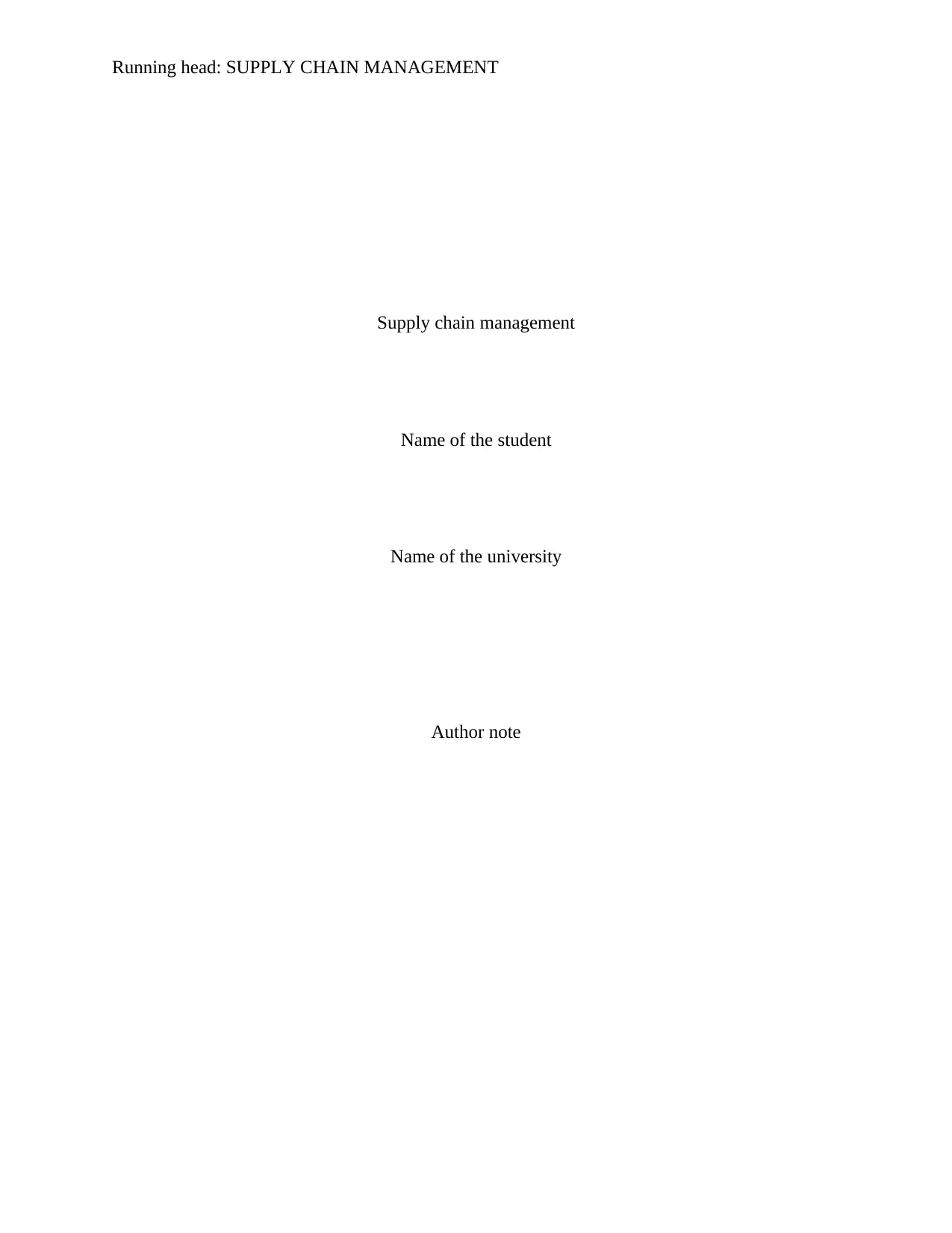
Running head: SUPPLY CHAIN MANAGEMENT
Supply chain management
Name of the student
Name of the university
Author note
Supply chain management
Name of the student
Name of the university
Author note
Paraphrase This Document
Need a fresh take? Get an instant paraphrase of this document with our AI Paraphraser
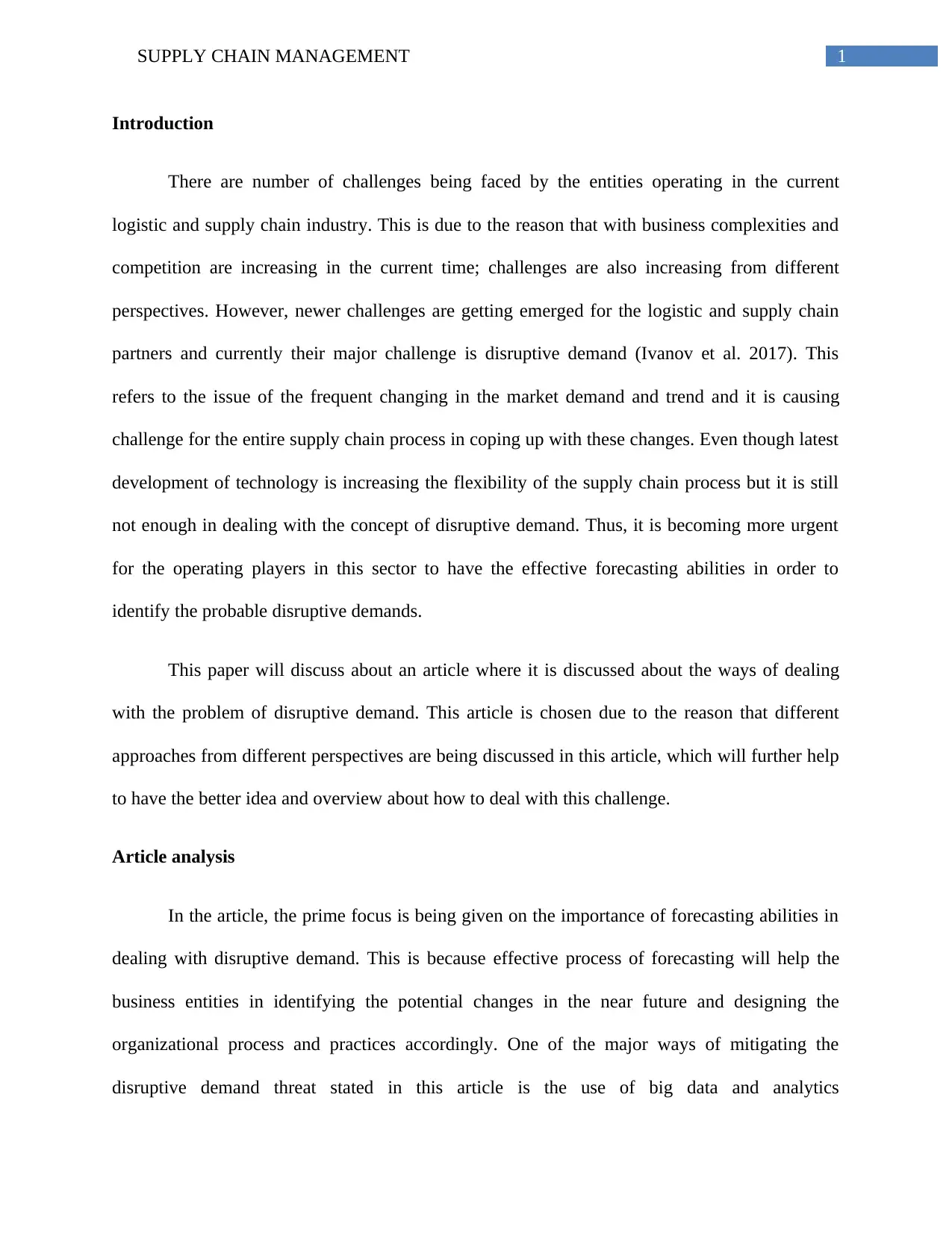
1SUPPLY CHAIN MANAGEMENT
Introduction
There are number of challenges being faced by the entities operating in the current
logistic and supply chain industry. This is due to the reason that with business complexities and
competition are increasing in the current time; challenges are also increasing from different
perspectives. However, newer challenges are getting emerged for the logistic and supply chain
partners and currently their major challenge is disruptive demand (Ivanov et al. 2017). This
refers to the issue of the frequent changing in the market demand and trend and it is causing
challenge for the entire supply chain process in coping up with these changes. Even though latest
development of technology is increasing the flexibility of the supply chain process but it is still
not enough in dealing with the concept of disruptive demand. Thus, it is becoming more urgent
for the operating players in this sector to have the effective forecasting abilities in order to
identify the probable disruptive demands.
This paper will discuss about an article where it is discussed about the ways of dealing
with the problem of disruptive demand. This article is chosen due to the reason that different
approaches from different perspectives are being discussed in this article, which will further help
to have the better idea and overview about how to deal with this challenge.
Article analysis
In the article, the prime focus is being given on the importance of forecasting abilities in
dealing with disruptive demand. This is because effective process of forecasting will help the
business entities in identifying the potential changes in the near future and designing the
organizational process and practices accordingly. One of the major ways of mitigating the
disruptive demand threat stated in this article is the use of big data and analytics
Introduction
There are number of challenges being faced by the entities operating in the current
logistic and supply chain industry. This is due to the reason that with business complexities and
competition are increasing in the current time; challenges are also increasing from different
perspectives. However, newer challenges are getting emerged for the logistic and supply chain
partners and currently their major challenge is disruptive demand (Ivanov et al. 2017). This
refers to the issue of the frequent changing in the market demand and trend and it is causing
challenge for the entire supply chain process in coping up with these changes. Even though latest
development of technology is increasing the flexibility of the supply chain process but it is still
not enough in dealing with the concept of disruptive demand. Thus, it is becoming more urgent
for the operating players in this sector to have the effective forecasting abilities in order to
identify the probable disruptive demands.
This paper will discuss about an article where it is discussed about the ways of dealing
with the problem of disruptive demand. This article is chosen due to the reason that different
approaches from different perspectives are being discussed in this article, which will further help
to have the better idea and overview about how to deal with this challenge.
Article analysis
In the article, the prime focus is being given on the importance of forecasting abilities in
dealing with disruptive demand. This is because effective process of forecasting will help the
business entities in identifying the potential changes in the near future and designing the
organizational process and practices accordingly. One of the major ways of mitigating the
disruptive demand threat stated in this article is the use of big data and analytics
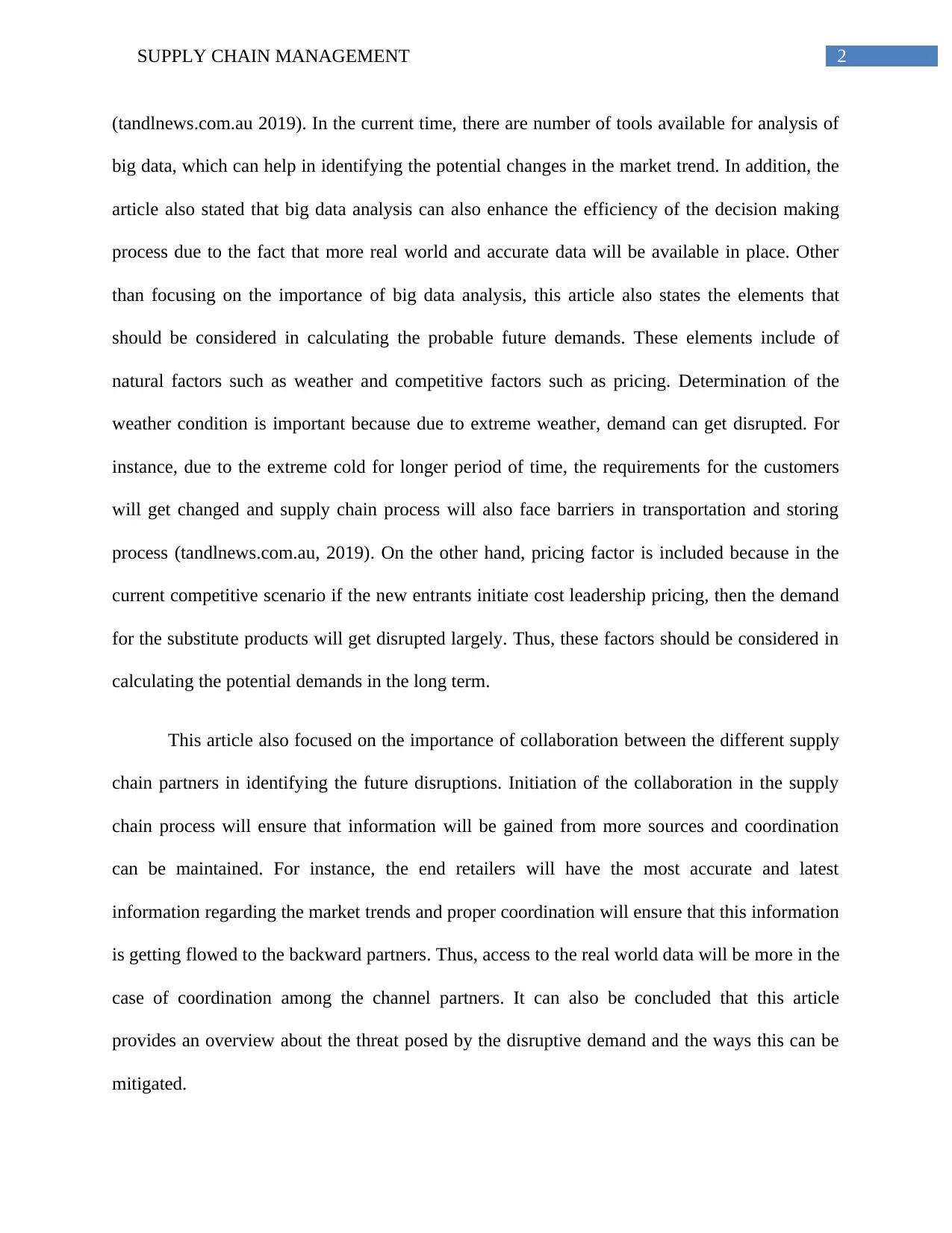
2SUPPLY CHAIN MANAGEMENT
(tandlnews.com.au 2019). In the current time, there are number of tools available for analysis of
big data, which can help in identifying the potential changes in the market trend. In addition, the
article also stated that big data analysis can also enhance the efficiency of the decision making
process due to the fact that more real world and accurate data will be available in place. Other
than focusing on the importance of big data analysis, this article also states the elements that
should be considered in calculating the probable future demands. These elements include of
natural factors such as weather and competitive factors such as pricing. Determination of the
weather condition is important because due to extreme weather, demand can get disrupted. For
instance, due to the extreme cold for longer period of time, the requirements for the customers
will get changed and supply chain process will also face barriers in transportation and storing
process (tandlnews.com.au, 2019). On the other hand, pricing factor is included because in the
current competitive scenario if the new entrants initiate cost leadership pricing, then the demand
for the substitute products will get disrupted largely. Thus, these factors should be considered in
calculating the potential demands in the long term.
This article also focused on the importance of collaboration between the different supply
chain partners in identifying the future disruptions. Initiation of the collaboration in the supply
chain process will ensure that information will be gained from more sources and coordination
can be maintained. For instance, the end retailers will have the most accurate and latest
information regarding the market trends and proper coordination will ensure that this information
is getting flowed to the backward partners. Thus, access to the real world data will be more in the
case of coordination among the channel partners. It can also be concluded that this article
provides an overview about the threat posed by the disruptive demand and the ways this can be
mitigated.
(tandlnews.com.au 2019). In the current time, there are number of tools available for analysis of
big data, which can help in identifying the potential changes in the market trend. In addition, the
article also stated that big data analysis can also enhance the efficiency of the decision making
process due to the fact that more real world and accurate data will be available in place. Other
than focusing on the importance of big data analysis, this article also states the elements that
should be considered in calculating the probable future demands. These elements include of
natural factors such as weather and competitive factors such as pricing. Determination of the
weather condition is important because due to extreme weather, demand can get disrupted. For
instance, due to the extreme cold for longer period of time, the requirements for the customers
will get changed and supply chain process will also face barriers in transportation and storing
process (tandlnews.com.au, 2019). On the other hand, pricing factor is included because in the
current competitive scenario if the new entrants initiate cost leadership pricing, then the demand
for the substitute products will get disrupted largely. Thus, these factors should be considered in
calculating the potential demands in the long term.
This article also focused on the importance of collaboration between the different supply
chain partners in identifying the future disruptions. Initiation of the collaboration in the supply
chain process will ensure that information will be gained from more sources and coordination
can be maintained. For instance, the end retailers will have the most accurate and latest
information regarding the market trends and proper coordination will ensure that this information
is getting flowed to the backward partners. Thus, access to the real world data will be more in the
case of coordination among the channel partners. It can also be concluded that this article
provides an overview about the threat posed by the disruptive demand and the ways this can be
mitigated.
⊘ This is a preview!⊘
Do you want full access?
Subscribe today to unlock all pages.

Trusted by 1+ million students worldwide
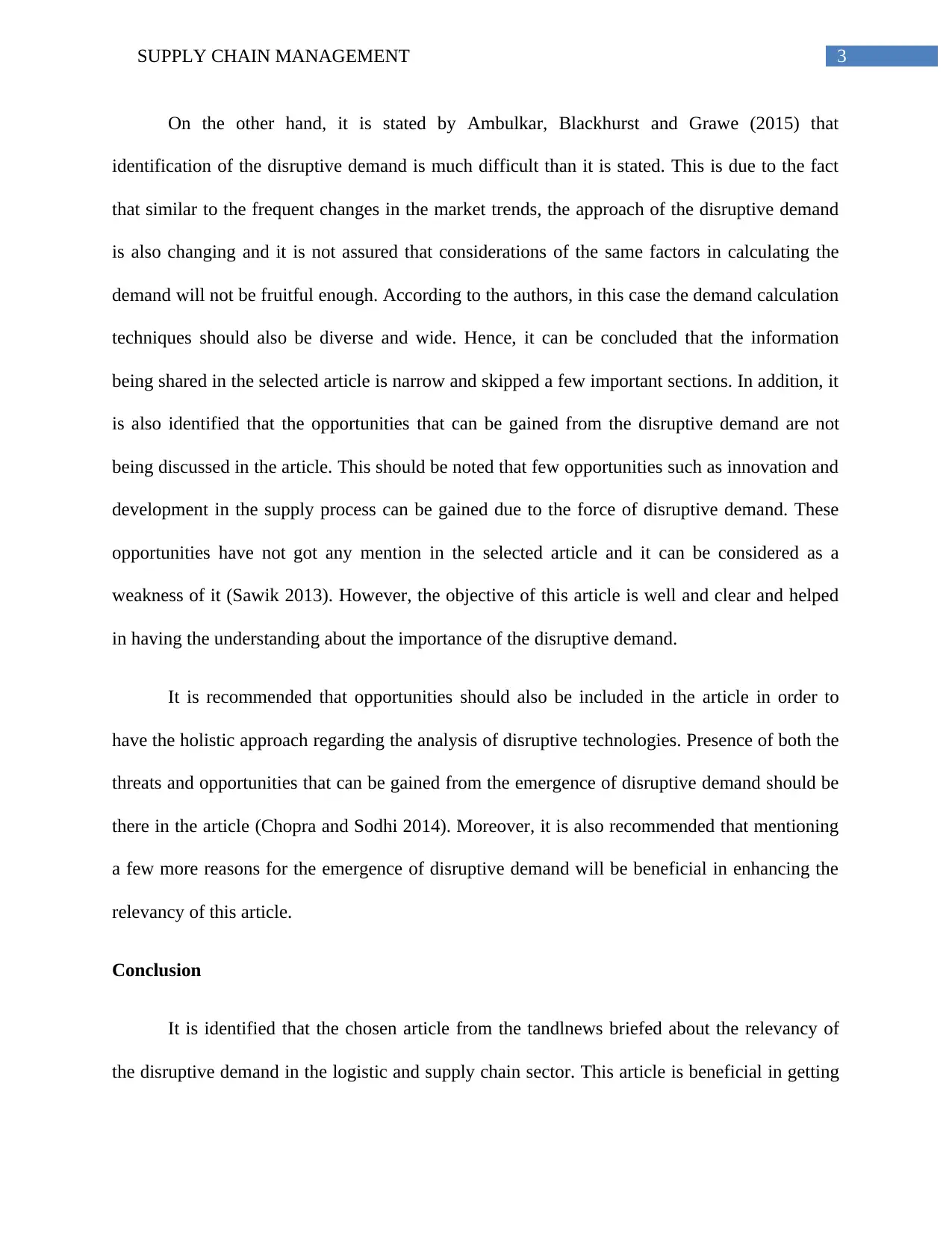
3SUPPLY CHAIN MANAGEMENT
On the other hand, it is stated by Ambulkar, Blackhurst and Grawe (2015) that
identification of the disruptive demand is much difficult than it is stated. This is due to the fact
that similar to the frequent changes in the market trends, the approach of the disruptive demand
is also changing and it is not assured that considerations of the same factors in calculating the
demand will not be fruitful enough. According to the authors, in this case the demand calculation
techniques should also be diverse and wide. Hence, it can be concluded that the information
being shared in the selected article is narrow and skipped a few important sections. In addition, it
is also identified that the opportunities that can be gained from the disruptive demand are not
being discussed in the article. This should be noted that few opportunities such as innovation and
development in the supply process can be gained due to the force of disruptive demand. These
opportunities have not got any mention in the selected article and it can be considered as a
weakness of it (Sawik 2013). However, the objective of this article is well and clear and helped
in having the understanding about the importance of the disruptive demand.
It is recommended that opportunities should also be included in the article in order to
have the holistic approach regarding the analysis of disruptive technologies. Presence of both the
threats and opportunities that can be gained from the emergence of disruptive demand should be
there in the article (Chopra and Sodhi 2014). Moreover, it is also recommended that mentioning
a few more reasons for the emergence of disruptive demand will be beneficial in enhancing the
relevancy of this article.
Conclusion
It is identified that the chosen article from the tandlnews briefed about the relevancy of
the disruptive demand in the logistic and supply chain sector. This article is beneficial in getting
On the other hand, it is stated by Ambulkar, Blackhurst and Grawe (2015) that
identification of the disruptive demand is much difficult than it is stated. This is due to the fact
that similar to the frequent changes in the market trends, the approach of the disruptive demand
is also changing and it is not assured that considerations of the same factors in calculating the
demand will not be fruitful enough. According to the authors, in this case the demand calculation
techniques should also be diverse and wide. Hence, it can be concluded that the information
being shared in the selected article is narrow and skipped a few important sections. In addition, it
is also identified that the opportunities that can be gained from the disruptive demand are not
being discussed in the article. This should be noted that few opportunities such as innovation and
development in the supply process can be gained due to the force of disruptive demand. These
opportunities have not got any mention in the selected article and it can be considered as a
weakness of it (Sawik 2013). However, the objective of this article is well and clear and helped
in having the understanding about the importance of the disruptive demand.
It is recommended that opportunities should also be included in the article in order to
have the holistic approach regarding the analysis of disruptive technologies. Presence of both the
threats and opportunities that can be gained from the emergence of disruptive demand should be
there in the article (Chopra and Sodhi 2014). Moreover, it is also recommended that mentioning
a few more reasons for the emergence of disruptive demand will be beneficial in enhancing the
relevancy of this article.
Conclusion
It is identified that the chosen article from the tandlnews briefed about the relevancy of
the disruptive demand in the logistic and supply chain sector. This article is beneficial in getting
Paraphrase This Document
Need a fresh take? Get an instant paraphrase of this document with our AI Paraphraser
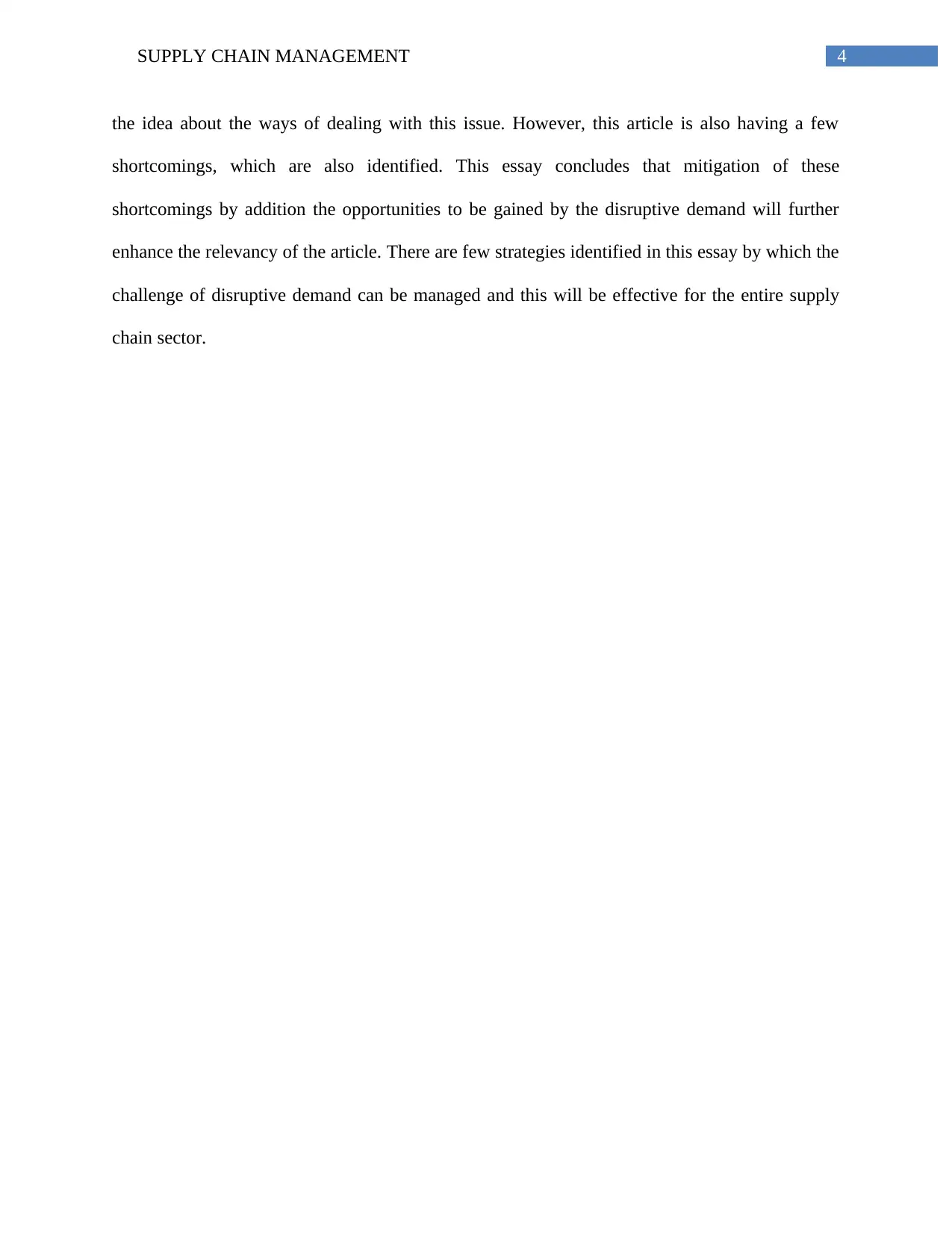
4SUPPLY CHAIN MANAGEMENT
the idea about the ways of dealing with this issue. However, this article is also having a few
shortcomings, which are also identified. This essay concludes that mitigation of these
shortcomings by addition the opportunities to be gained by the disruptive demand will further
enhance the relevancy of the article. There are few strategies identified in this essay by which the
challenge of disruptive demand can be managed and this will be effective for the entire supply
chain sector.
the idea about the ways of dealing with this issue. However, this article is also having a few
shortcomings, which are also identified. This essay concludes that mitigation of these
shortcomings by addition the opportunities to be gained by the disruptive demand will further
enhance the relevancy of the article. There are few strategies identified in this essay by which the
challenge of disruptive demand can be managed and this will be effective for the entire supply
chain sector.
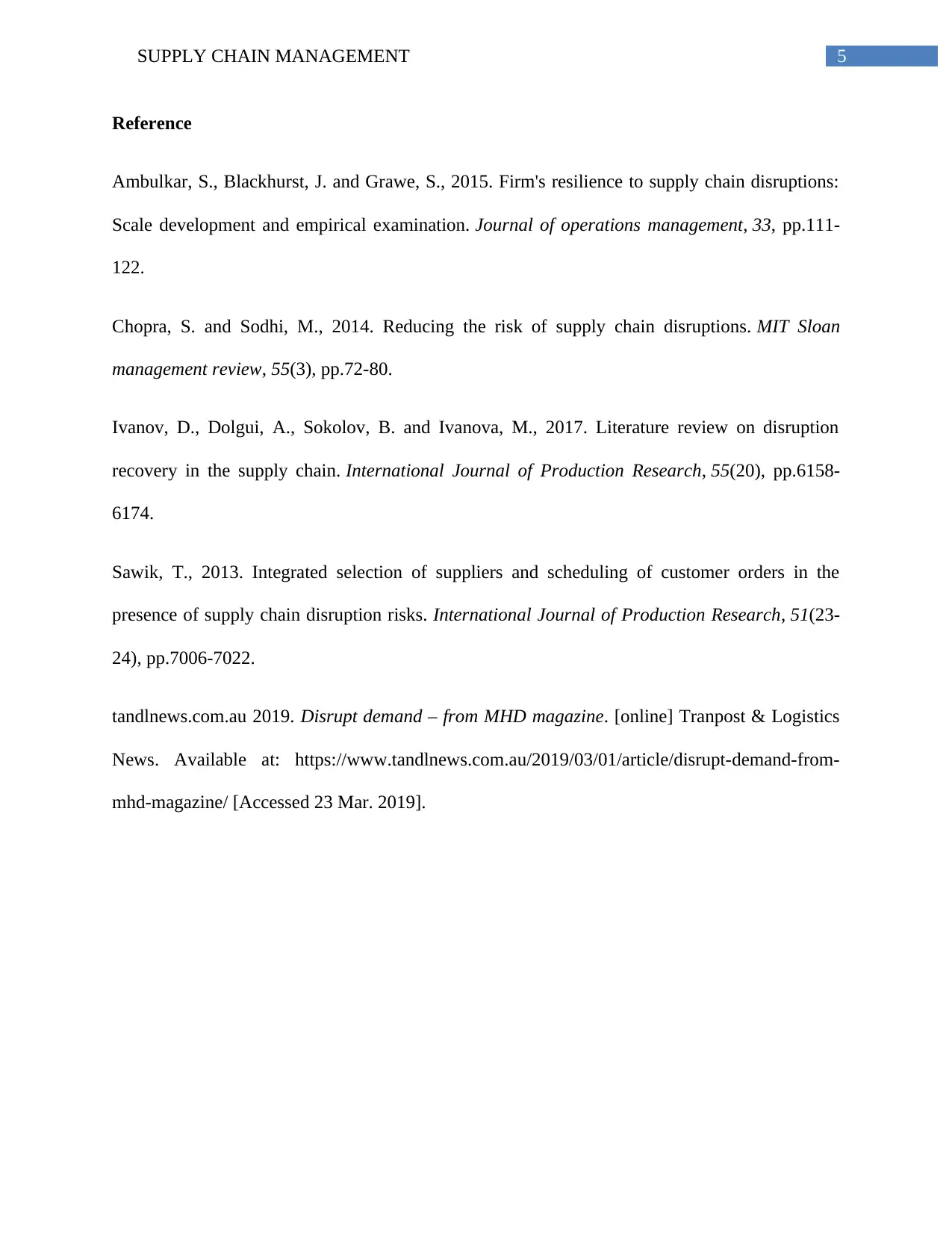
5SUPPLY CHAIN MANAGEMENT
Reference
Ambulkar, S., Blackhurst, J. and Grawe, S., 2015. Firm's resilience to supply chain disruptions:
Scale development and empirical examination. Journal of operations management, 33, pp.111-
122.
Chopra, S. and Sodhi, M., 2014. Reducing the risk of supply chain disruptions. MIT Sloan
management review, 55(3), pp.72-80.
Ivanov, D., Dolgui, A., Sokolov, B. and Ivanova, M., 2017. Literature review on disruption
recovery in the supply chain. International Journal of Production Research, 55(20), pp.6158-
6174.
Sawik, T., 2013. Integrated selection of suppliers and scheduling of customer orders in the
presence of supply chain disruption risks. International Journal of Production Research, 51(23-
24), pp.7006-7022.
tandlnews.com.au 2019. Disrupt demand – from MHD magazine. [online] Tranpost & Logistics
News. Available at: https://www.tandlnews.com.au/2019/03/01/article/disrupt-demand-from-
mhd-magazine/ [Accessed 23 Mar. 2019].
Reference
Ambulkar, S., Blackhurst, J. and Grawe, S., 2015. Firm's resilience to supply chain disruptions:
Scale development and empirical examination. Journal of operations management, 33, pp.111-
122.
Chopra, S. and Sodhi, M., 2014. Reducing the risk of supply chain disruptions. MIT Sloan
management review, 55(3), pp.72-80.
Ivanov, D., Dolgui, A., Sokolov, B. and Ivanova, M., 2017. Literature review on disruption
recovery in the supply chain. International Journal of Production Research, 55(20), pp.6158-
6174.
Sawik, T., 2013. Integrated selection of suppliers and scheduling of customer orders in the
presence of supply chain disruption risks. International Journal of Production Research, 51(23-
24), pp.7006-7022.
tandlnews.com.au 2019. Disrupt demand – from MHD magazine. [online] Tranpost & Logistics
News. Available at: https://www.tandlnews.com.au/2019/03/01/article/disrupt-demand-from-
mhd-magazine/ [Accessed 23 Mar. 2019].
⊘ This is a preview!⊘
Do you want full access?
Subscribe today to unlock all pages.

Trusted by 1+ million students worldwide
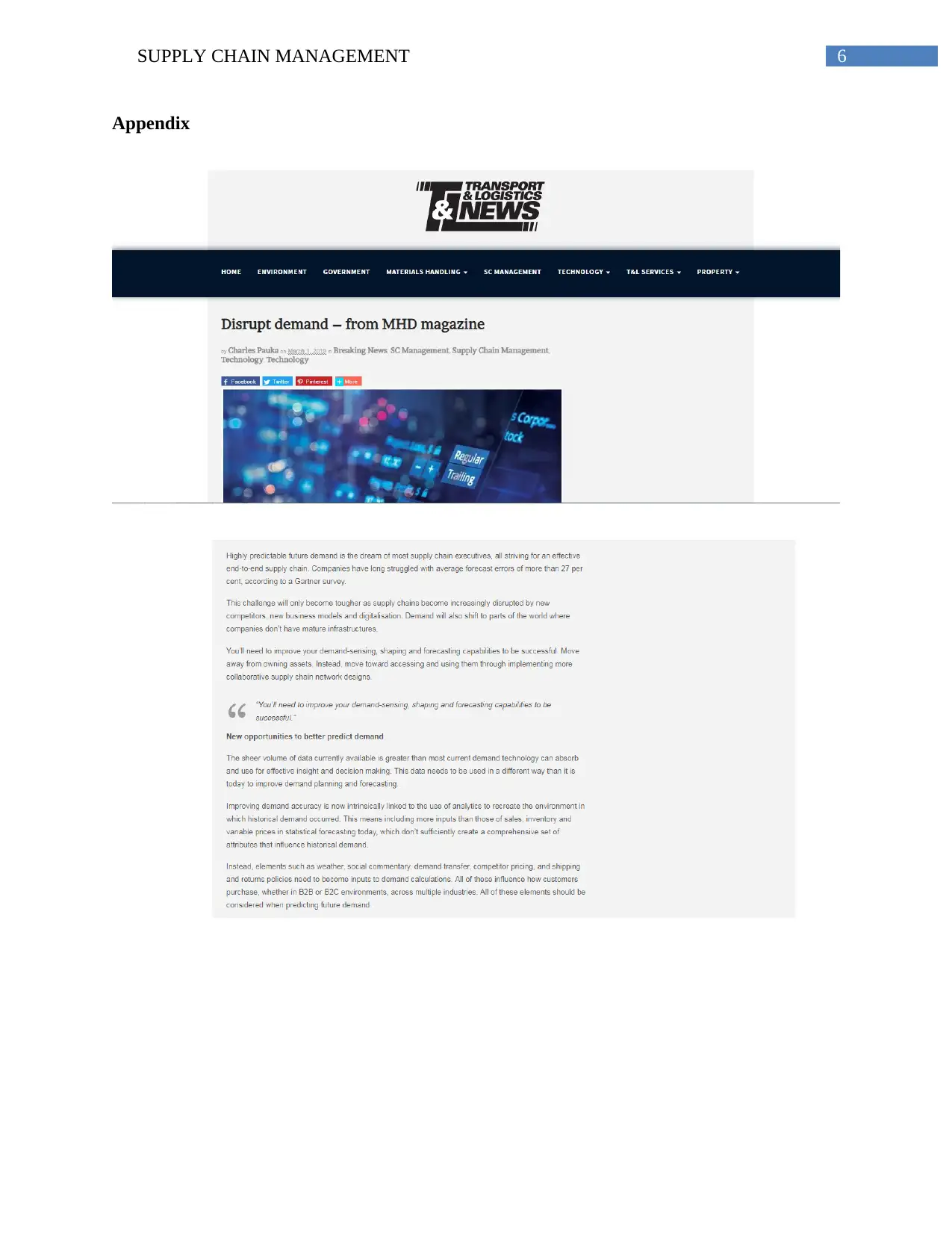
6SUPPLY CHAIN MANAGEMENT
Appendix
Appendix
Paraphrase This Document
Need a fresh take? Get an instant paraphrase of this document with our AI Paraphraser
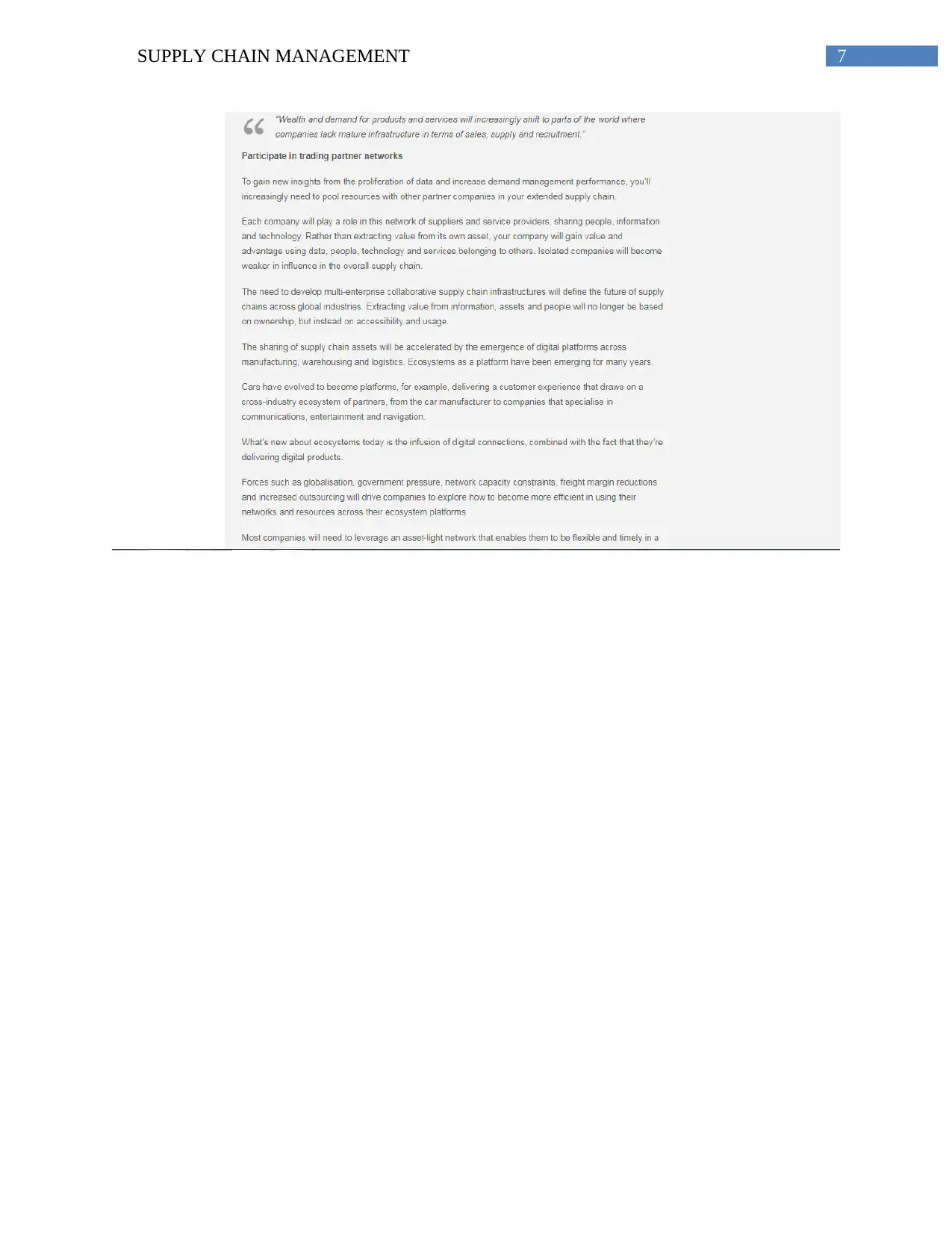
7SUPPLY CHAIN MANAGEMENT
1 out of 8
Related Documents
Your All-in-One AI-Powered Toolkit for Academic Success.
+13062052269
info@desklib.com
Available 24*7 on WhatsApp / Email
![[object Object]](/_next/static/media/star-bottom.7253800d.svg)
Unlock your academic potential
Copyright © 2020–2025 A2Z Services. All Rights Reserved. Developed and managed by ZUCOL.





